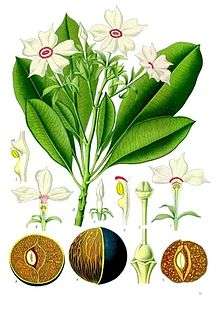Cerbera
Cerbera is a genus of evergreen small trees or shrubs, native to tropical Asia, Australia, Madagascar, and various islands in the Indian Ocean and the western Pacific Ocean.[2][3][4]
| Cerbera | |
|---|---|
 | |
| Cerbera manghas[1] | |
| Scientific classification | |
| Kingdom: | Plantae |
| Clade: | Tracheophytes |
| Clade: | Angiosperms |
| Clade: | Eudicots |
| Clade: | Asterids |
| Order: | Gentianales |
| Family: | Apocynaceae |
| Subfamily: | Rauvolfioideae |
| Tribe: | Plumerieae |
| Subtribe: | Thevetiinae |
| Genus: | Cerbera L., 1753 |
| Type species | |
| Cerbera manghas L., 1753 | |
| Synonyms[2] | |
| |
Three trees of this genus are mangroves, Cerbera floribunda, Cerbera manghas and Cerbera odollam.
The leaves are alternate and lack interpetiolar stipules. The tubular corollas are actinomorphic, i.e. they are symmetric and can be divided in halves along any diameter. All trees contain a white latex. The fruits are drupes.
The genus is named after Cerberus because all its parts are poisonous : they contain cerberin, a cardiac glycoside, a substance that blocks electric impulses in the body (including the beating of the heart). Never use Cerbera wood to light a fire. Even its smoke may cause poisoning.
The genus is related to Cerberiopsis,[5] endemic to New Caledonia.
- Species[2]
- Cerbera dilatata Markgraf. - Chiute - Mariana Islands
- Cerbera dumicola P.I.Forst. - Queensland
- Cerbera floribunda K. Schumann – Cassowary Plum - Queensland, New Guinea, Maluku, Sulawesi, Solomon Islands, Bismarck Archipelago, Micronesia
- Cerbera inflata S.T. Blake – Grey Milkwood, Milky Pine - Queensland, Papua New Guinea, Bismarck Archipelago
- Cerbera laeta A.J.M.Leeuwenberg - Papua New Guinea
- Cerbera manghas L. - Tanzania, Madagascar, Comoros, Seychelles, Mauritius, India, Sri Lanka, Bangladesh, S China, Ryukyu Islands, Andaman & Nicobar Islands, Indochina, insular Southeast Asia, N Australia, numerous Pacific islands
- Cerbera odollam Gaertn. – Suicide Tree - India, Sri Lanka, Bangladesh, Andaman & Nicobar Islands, Indochina, insular Southeast Asia, Queensland, numerous Pacific islands
- formerly included
- Cerbera obovata Roem. & Schult. = Craspidospermum verticillatum Bojer ex Decne.
- Cerbera oppositifolia Lam. = Ochrosia oppositifolia (Lam.) K.Schum.
References
- 1897 illustration from Franz Eugen Köhler, Köhler's Medizinal-Pflanzen
- "World Checklist of Selected Plant Families". Retrieved May 21, 2014.
- Forster, P. I. (1992). "A taxonomic revision of Cerbera L. (Apocynaceae) in Australia and Papuasia". Austrobaileya. 3 (4): 569–579.
- Leeuwenberg, A. J. M. (1999). "Series of revisions of Apocynaceae XLVII. The genus Cerbera L". Agric. Univ. Wageningen Pap. 98–3: 1–64.
- Potgieter, K., and V. A. Albert. (2001) Phylogenetic Relationships within Apocynaceae S.l. Based on trnL Intron and trnL-F Spacer Sequences and Propagule Characters.” Annals of the Missouri Botanical Garden 88 (4): 523–49.
Gallery
 Cerbera manghas tree in Hong Kong, early June.
Cerbera manghas tree in Hong Kong, early June. Cerbera manghas flowers
Cerbera manghas flowers
| Wikimedia Commons has media related to Cerbera. |